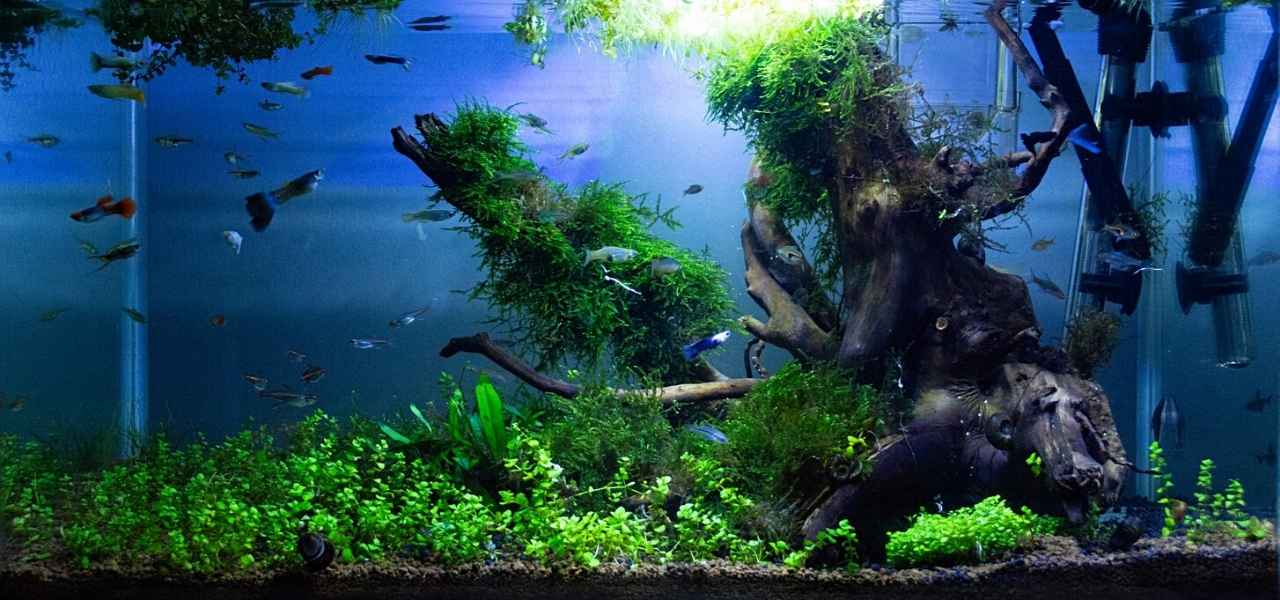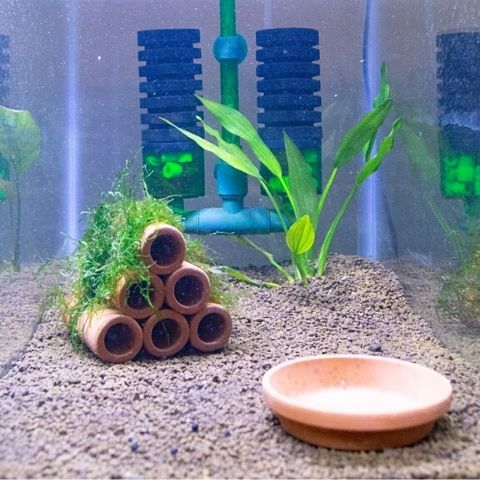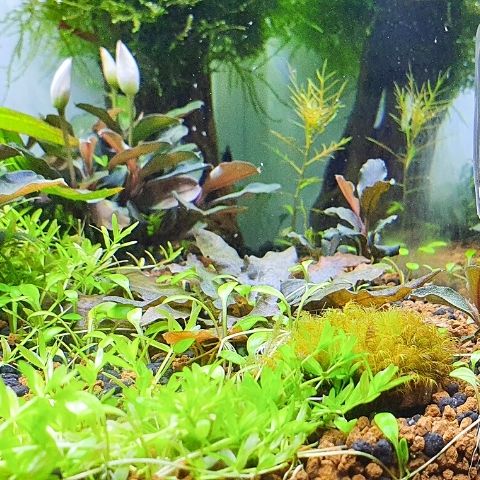Your Cart is Empty
spend R1000. 2kg or less. free shipping.
Menu

spend R1000. 2kg or less. free shipping.
bonsai
gardening
Orchids

Aquaria: An Introduction
6 min read
By Cecil and Monique Dunhin
Overview
In this first part of a series on aquariums, the Dunhin’s introduce the reader to some of the decisions a hobbyist will need to make when getting started. The example below deals with the setting up of a tropical tank. The choices made by the authors are not explained in detail in this part but will be explored in greater depth over the series.
The object of this series is to help the reader set up their own tank whether it be a planted, shrimp, tropical or mixed tank.
Getting started
So you have decided to start a tropical tank. Your first step in a long-term commitment. What type of tank are you choosing to do? Fish tank – Nano, community, single species tank or shrimp tank. Once you have decided, it’s always a good thing to do a little research about the type of livestock that will be introduced into the tank.
For us, we decided to go with a shrimp breeding tank.

The tank
The next most obvious step is the tank. What size tank will meet your requirements? There is nothing wrong with shopping around, in fact you should, look for what is going to meet your requirements. If you don’t find something off the shelf, ask your local pet store or FB Groups if they know of, or could refer you to someone who custom builds tanks. Our decision was based on a few factors:
- Firstly, our long term goal of breeding with shrimp was the biggest influencer for us.
- The space that we had marked out for this project was somewhat limited. With this in mind, we then had to decide, were we going to go with multiple separate tanks or a single tank? Again, the space we had available was the deciding factor for us. However, we could have both options by having one large tank that was divided into five sections. We had seen this concept at various pet stores, but on a much smaller scale.
The other choice that we had to make was, were we going to go with an acrylic tank or a glass tank. Acrylic tanks are on the whole, more expensive due to the construction and labour intensive process. Another factor to keep in mind with acrylic tanks is that if you are not careful, they can scratch easily. We chose to go with a glass tank this being the more cost effective option for us.
We were referred to Aquatic Discovery, where we then discussed our idea and dimensions of the tank, 1.2m long x 46cm wide x 30cm high. The dimensions of the tank were then then divided into 5 sections or “mini tanks’’ measuring 25cm wide. So our journey begins.
Filters and Pumps
The second thing that you are going to look at is filters and pumps. Once you have established your tank and what size your tank is going to be, you will then need to get an appropriate sized filter / pump, internal or external? These are all questions to answer before going out and buying the first filter / pump that could work. Keep in mind that this is going to be a vital part of your tank and keeping your tank healthy in more ways than one.

For us, we wanted each tank to have its own sponge filter. The reason for going with the sponge filter is that it is a compact filter and essentially only required for a small tank. Another reason behind choosing the sponge filter is that it reduces the risk of the shrimplets from being sucked up and into the pipes.
After doing a lot of research our choice narrowed down to the Qanvee Bio Sponge Filter 100A. The pump that we decided on, is the Sobo SB-860A this genius little pump is a work horse and an added bonus, it’s designed as a near silent pump and energy efficient. Both the filters and the pump were purchased from Parrot Inn, in Centurion.
For this setup to work we purchased a metal 5 way splitter along with the tubing, these were purchased from Aqua Empire in Randburg. The sponge filters each have a section where you can add bio filter media.
Bio filter media aids in the breaking down of the bad bacteria in the tank and additionally assist with the development of natural healthy bacteria in your tank. The ceramic bio media was purchased from Family Pet Centre in Centurion and the Lava Rock bio media was purchased from Mcmerwe Pet Store in Bloemfontein.

Substrate
The next step is to decide what substrate to use. This is a critical decision. Once the substrate has been added to the tank the only way to go back, is to start over. Our decision was an easy one. We have used aqua soil in our other tanks for planting live plants and have been very satisfied with the outcome. For our tank this time around, we chose to use Japanese Akadama 1 – 3 mm granules 14L bag.

The Japanese Akadama lowers the PH levels and with the small granule size, it’s ideal for the shrimps to forage in. It also contributes to plants flourishing in the tanks. We then calculated how to split the Japanese Akadama between the 5 tanks. This worked out to 2.5L of soil per tank and sits at a depth of 2 cm per tank. The Japanese Akadama was not pre-rinsed or sifted before adding to the tanks.
Cycling
Then the fun begins. We only use Reversed Osmosis (R.O.) water in our tanks. As slow as possible, we started adding the R.O. water to the tank. This did mix up and move the Japanese Akadama around and yes, the water did turn muddy with all the fine particles of the Japanese Akadama floating around. Once the tanks were filled, we left them to cycle through the night. The next morning, the water was almost perfect. After cleaning the filters off and removing the bigger particles (small twigs and grass) and letting the tanks continue to cycle. A few hours later the water was crystal clear.

Over the next week, on a daily basis Seachem Stabiliy, ADA Brighty Green Neutral K was added to the tank as well as Shrimp GH Salts. Dosing was done as per instructions of each product to each tank. It is a very important step to cycle the tanks. You want your tanks to run for a few weeks before adding any livestock. This gives the tank a chance to settle as well as stabilize.
Adding livestock
Two days of letting the tanks cycle, we proceeded to add Amazon Sword plants an aquatic low maintenance and a great plant for beginners and it adds height as well. As these are breeding tanks, we did not want to over plant the tanks. We also used christmas moss to cover the terracotta pyramid hides to add another shade of green to the breeding tanks, the terracotta pyramids were purchased from Saturn Shrimp in Centurion.

Feeding dishes are not a necessity, however if you decided to use them, it boils down to personal choice. The feeding dishes that we chose to go with are terracotta dishes these tie back into the natural theme that we are going with for our breeding tanks. The terracotta dishes were purchased from our local nursery.

Four days into the cycling we added in Betta fish to the tanks for the cycling process to encourage natural bio additives for the tank. The tanks have continued to cycle.
Lastly the lights were added to the tank. There are a multitude of options out there, endless choices of styles, sizes, colour variations. Lights can be mounted over tanks in various ways. You can also get lights that can be submerged inside the tank. The options are endless. Our choice was to go with an LED clip on lights. Again our choice was that for us it would create the natural light and that an LED light is energy efficient.

Conclusion
If you are new to this hobby it’s very easy to get carried away. Remember to consider all aspects of your tank and to do thorough research and planning before you get started. Your tank should first and foremost be for you to enjoy and we are going to help you with the process. Check back soon for the next part where we will focus on getting started and the types of tanks you can create in your home.

Cecil (41) and Monique (38) have been married for 10 years and have a son (7). They live in Centurion. Cecil has been keeping tropical fish tanks since primary school, as well as bonsai trees. Monique has been keeping tropical shrimp for a year now. They decided to create an all-natural tropical fish tank for their son to ignite his interest into the hobby as well. Their experience in creating tropical tanks is an ongoing process and they continue to learn from each tank that they create. This hobby allows for the beauty, creativity and freedom to experiment and build on each new tank. Contact Cecil & Monique Dunhin in Centurion on cdunhin@yahoo.com or monique.dunhin@gmail.com
Leave a comment
Comments will be approved before showing up.
Recent Articles
- Enthusiasts Top Wiring Tips July 17, 2023
- Top fertilizing tips March 28, 2023
- Top watering tips February 13, 2023
- Creating Japanese Maple forests October 24, 2022
- How to dig bonsai material August 15, 2022
- How I style bonsai and you can too April 30, 2022
- Swamp Cypress Bonsai Styling July 03, 2021
- How to hide large scars quickly June 14, 2021
- 14 Tips for Field Growing Bonsai May 31, 2021
- Aquaria: An Introduction January 06, 2021

FREE SAMPLE GIVEAWAY!
We are giving away samples of our new product, SuperBoost fertilizer pellets.
A unique organic blend of Blood meal, Bone meal, Canola meal, Fish meal, Fish hydrolysate. Macro, micro and trace minerals. Plant natural stimulating hormones, enzymes and amino acids.




